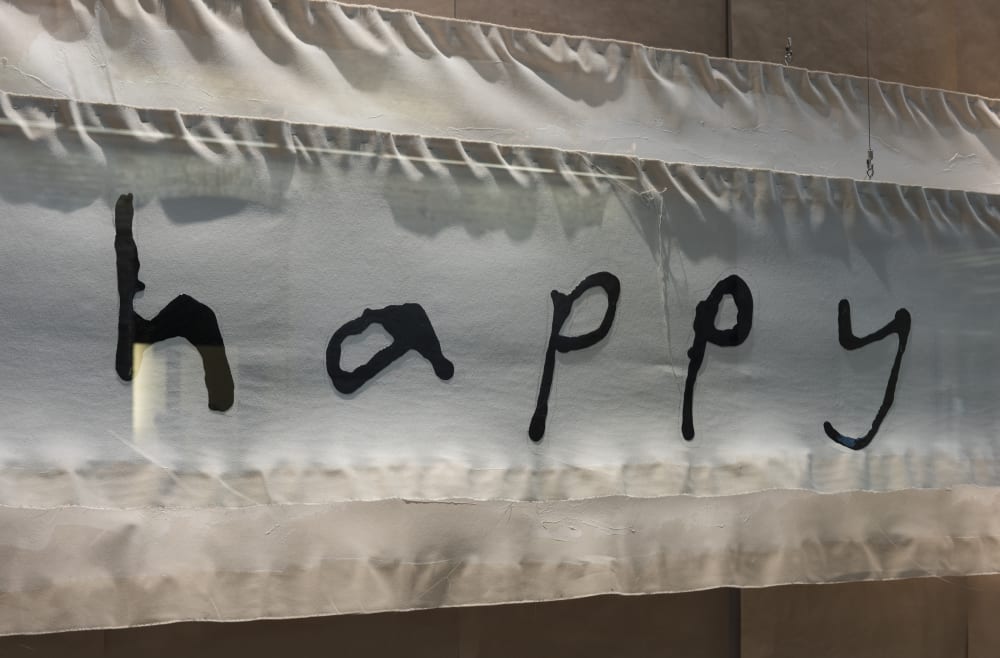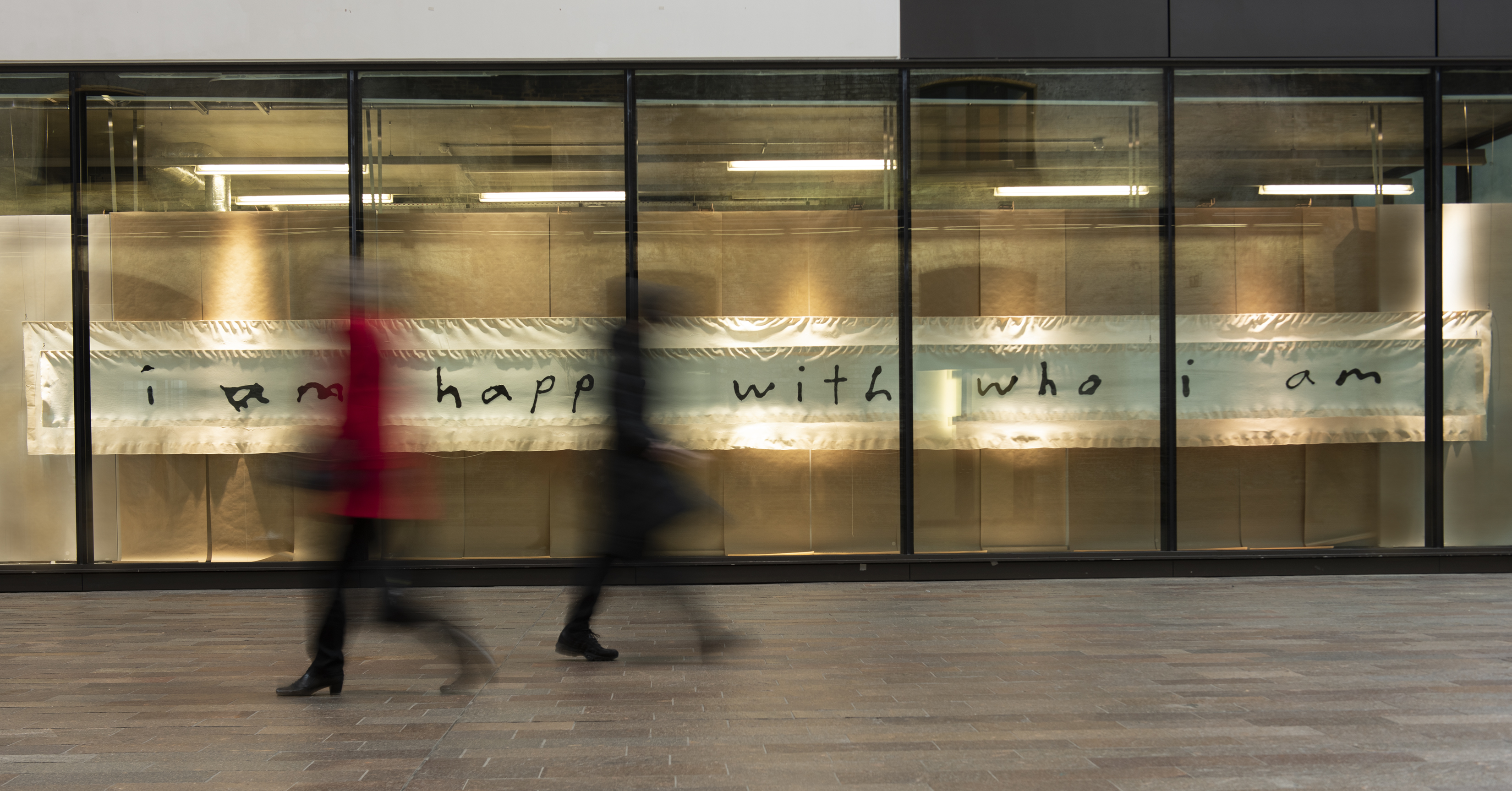At the end of last year, BA Fine Art student Lewis Buttery was selected for the annual Big White Wall project. With his winning work now installed in our Window Galleries, we spoke to Buttery about his monumental words of affirmation and the potential for art to spread positivity.
Big White Wall was first initiated in 2013 by former Dean of Academic Programmes Mark Dunhill to give Fine Art students the opportunity to realise a temporary artwork in the College’s public exhibition spaces. Since then, the project has expanded into a multi-site exhibition, with a Camberwell College of Art student also being selected to exhibit on their campus. In addition to the exhibition opportunity, £1,000 worth of materials are donated to each student by Cass Art and Liquitex, allowing them to create a site-specific work at an ambitious scale.
Big White Wall is inspired by histories of fresco and mural painting and previous iterations have transformed large public sites in the College. This year, in a slight departure from the tradition of wall murals, students were asked to propose a work to take over our distinctive Window Galleries. Buttery, a second-year student on the 2D pathway, was selected for his multi-layered, text-based artwork which explores how audiences internalise what they read: “For the show, I’ve suspended two 12-metre long canvases in the windows with words of affirmation written on them. When I proposed the work, I was thinking about how people engage with what they read, especially when there is no context. So, the idea is that, hopefully, as people walk through the space, they will read the phrases and it will uplift them,” explains Buttery.

The two phrases – “I am happy with who I am” and “I am living a great life” – were taken from a YouTube video the artist watched during a particularly difficult week: "I was making work while I was watching this video and anytime a phrase stood out to me as something I needed to hear at that point, I wrote it down. Eventually I had written down every single one in the video.” Buttery’s text work has always been an exploration of his own mental state – an act of catharsis when dealing with a history of social anxiety disorder.
“Before, I was writing out negative thoughts but people didn’t always react well to it. This made me realise that my work doesn’t exist in a vacuum, so I wanted to try and create something helpful instead to spread positivity.”

The works on display are an extension of smaller versions Buttery has been working on in his studio. Scaling them up to this size for Big White Wall allowed him to experiment with different making processes. Initially he visited the Liquitex laboratory and studios to test and play around with their materials. “When I work on these at A5 I use ink and it’s got this sort of blotchy quality. I was hoping to try and keep this effect on the text in the windows. After some tests, I ended up using acrylic paint mixed with a medium and it does look quite similar.” The resulting texts in the windows mirror the character of handwriting, with distinctive visual markers of the artist’s hand.
“Whenever I work, it’s usually very fast. I take time planning and then I’ll do all the making in one session. Because of that process, I accept any mistakes that happen. Some of the letters are distorted where areas of the paint have leaked out. At the time I was worried about it but, after taking a step back, I think it works. There are other bits which I didn’t know whether to leave in: the edges of the canvas are frayed, there are folds in the material and the brown paper is curling up at the bottom.
But all of that actually adds to the idea – because the work has imperfections, it’s maybe more human. I think it’s important to work on myself and to love and accept myself as I am, because self-improvement is a continual process and it doesn’t finish. Accepting the imperfections in the work is maybe a metaphor for that, or an extension of it.”

Buttery’s work offers a delicate balance between the private and the public. While it is a productive process for him to explore his own mental health, visitor interaction and engagement is also a key factor:
“When I first started making work it was self-taught and with a community group. I did it partially for myself but also as a social thing. So, other people’s reactions have always been a part of it for me. Because I’m not very confident, I used to worry about showing my work to anybody. The making was a process of catharsis as I was struggling with my mental health at that time and it became a way for me to deal with it. Because of that it’s intuitive for me to make work that’s quite dark. More recently, I’ve been making a conscious decision to try and move in a different direction. I’ve been thinking about how my work affects other people, which is why I wanted to put something positive in such a public space.”
The affirmations themselves are universal and designed for everyone. “I think it was good for me to use affirmations I hadn’t thought up myself – I didn’t want them to be specific to me. I wanted to choose things that everyone would associate with and want to believe.” Hung in the College’s most outward-facing, public space, Buttery’s works are a generous offering – a testament to the power of art to spread positivity.
Buttery’s work is on view at the College until 27 February 2020. BA Fine Art student Mateo Gabayet was selected for the concurrent exhibition at Camberwell College of Art. You can catch his site-specific work, inspired by the Mexican muralist movement, in Camberwell College of Art reception until 4 March. The Big White Wall Project is generously sponsored by Cass Art and ColArt (Liquitex).



